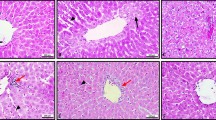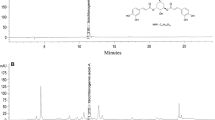Abstract
Background
There is increasing evidence indicating that the dietary intake of food with high antioxidant capacity may protect mitochondria from damage and exert positive effects on different pathogenic processes.
Aim of the study
The present study was designed to evaluate the possible protective effect of alcohol-free beer intake on chain components dysfunction of liver and heart mitochondria, and to compare with the effect of alcohol beer intake.
Methods
The study was carried out in rat heart and liver mitochondria by inducing with Adriamycin the dysfunction of the respiratory chain. Heart and liver mitochondria were isolated from rats and subjected to oxidative stress with two doses of Adriamycin (5 mg/Kg) 7 days from the beginning of consumption of both alcohol-free and alcohol beer during 31 days. Complexes I and IV and the levels of coenzymes Q9 and Q10 were evaluated and compared with a control group.
Results
Liver and heart mitochondria isolated from rats treated with Adryamicin showed a decrease in levels of complex I and complex IV enzymatic activity and in levels of coenzymes Q9 and Q10. Beer intake for itself does not affect any of the studied parameters. Therefore, the consumption of both alcohol and alcohol-free beer by rats treated with Adriamycin prevents the inhibition of enzymatic activities of complexes I and IV and the oxidation of coenzymes Q9 and Q10 in rat heart and liver mitochondria.
Conclusions
These results indicate that alcohol-free beer prevents adriamycin-induced damage to mitochondrial chain components and, therefore, helps to prevent mitochondrial dysfunction.




Similar content being viewed by others
References
Addolorato G, Leggio L, Ojetti V, Capristo E, Gasbarrini G, Gasbarrini A (2008) Effects of short-term moderate alcohol administration on oxidative stress and nutritional status in healthy males. Appetite 50(1):50–56
Bagchi D, Bagchi M, Hassoun EA, Kelly J, Stohs SJ (1995) Adriamycin-induced hepatic and myocardial lipid peroxidation and DNA damage an enhanced excretion of urinary lipid metabolites in rats. Toxicology 95:1–9
Barogi S, Baracca A, Cavazoni M, Castelli G, Lenaz G (2000) Effect of the oxidative stress induced by adriamycin on rat hepatocytes bioenergetics during ageing. Mech Ageing Dev 113:1–21
Bruckdorfer KR (2008) Antioxidants and CVD. Proc Nutr Soc 67(2):214–222
Crane FL (2001) Biochemical functions of coenzyme Q10. J Am Coll Nutr 20:591–598
Davies KJ, Doroshow JH (1986) Redox cycling of anthracyclines by cardiac mitochondira I. Antracycline radical formation by NADH dehydrogenase. J Biol Chem 261:3060–3067
Doroshow JH (1983) Antracycline antibiotic-stimulated superoxide, hydrogen peroxide, and hydroxyl radical production by NADH dehydrogenase. Cancer Res 43:4543–4551
Du Y, Lou H (2008) Catechin and proanthocyanidin B4 from grape seeds prevent doxorubicin-induced toxicity in cardiomyocytes. Eur J Pharmacol 4; 591(1–3):96–101
Genova ML, Pich MM, Biondi A, Bernachia A, Falasca A, Bovina C, Formigini G, Castelli G, Lenaz G (2003) Mitochondrial production of oxygen radical species and the role of Coenzyme Q as an antioxidant. Exp Biol Med 228(5):506–513
Ghiselli A, Natella F, Guidi A, Montanari L, Fantozzi P, Scaccini C (2000) Beer increases plasma antioxidant capacity in humans. J Nutr Biochem 11:76–80
Guzy J, Kusnir J, Marekova M, Chavkova Z, Dubayova G, Mojzisova L, Mirossay J, Mojzis J (2003) Effect of quercetin on Daunorubicin-induced heart mitochondria change in rats. Physiol Res 52:573–780
Huertas JR, Battino M, Lenaz G, Mataix FJ (1991) Changes in mitochondrial and microsomal rat liver coenzyme Q9 and Q10 conten induced by dietary fat and endogenous lipid peroxidation. FEBS 287:89–92
Kagan V, Serbinova E, Packer L (1990) Antioxidant effects of ubiquinones in microsomes and mitochondria are mediated by tocopherol recycling. Biochem Biophys Res Común 169:851–857
Lass A, Sohal RS (1999) Comparisons of coenzyme Q bound to mitochondrial membrane proteins among different mammalian species. Free Rad Biol Med 27(1–2):220–226
Lenaz G, Fato R, Formiggini G, Genova ML (2007) The role of Coenzyme Q in mitochondrial electron transport. Mitochondrion 7:S8–S33
Lowry OH, Rosebrough NJ, Farr AL, Randall RJ (1951) Protein measurement with the folin phenol reagent. J Biol Chem 193:265–275
Martinez-Alvarez JR, Valls-Belles V, López-Jaén M, Villariño-Marín A, Codoñer-Franch P (2009) Effects of alcohol-free beer on lipid profile and parameters of oxidative stress and inflammation in elderly women. Nutrition 25(2):182–187
Ott M, Gogvadze V, Orrenius S, Zhivotovsky B (2007) Mitochondria, oxidative stress and cell death. Apoptosis 12(5):913–922
Psotova J, Clopeikova S, Miketova P, Simanek V (2004) Chemoprotective effect of plant phenolics against anthracycline-induced toxicity on rat cardiomyocytes. Phyto Res 18:516–521
Quiles JL, Huertas JR, Battino M, Mataix J, Ramirez-Tortosa MC (2002) Antioxidant nutrients and adriamycin toxicity. Toxicology 30–180(1):79–95
Quiles JL, Ochoa JJ, Battino M, Gutierrez-Rios P, Nepomuceno EA, Frías ML, Huertas JR, Mataix J (2005) Life-long supplementation with a low dosage of coenzyme Q10 in the rat: effects on antioxidant status and DNA damage. Biofactors 25(1–4):73–86
Rice-Evans C (2001) Flavonoids antioxidants. Curr Med Chem 8:797–807
Rivero D, Perez-Magarino S, Gonzalez-Sanjosé ML, Valls-Belles V, Codoñer P, Muniz P (2005) Inhibition of induced DNA oxidative damage by beers: correlation with the content of polyphenols and melanoidins. J Agric Food Chem 53(9):3637–3642
Santos DL, Moreno AJM, Leino RL, Frobeg MK, Guayanes KB (2002) Carvedilol protects against doxorubicin-induced mitochondrial cardiomyopathy. Toxicol Applied Pharmacol 185:218–227
Sharma G, Tyagi A, Singh RP, Chan DCF, Agarwal R (2004) Synergistic anticancer effects of grape seed extract and conventional cytotoxic agent doxorobucin against human breast carcinoma cells. Breast Cancer Res Treat 85:1–12
Shigenaga MK, Hage TM, Ames BN (1994) Oxidative damage and mitochondrial decay in aging. Proc Natl Acad Sci USA 91:10771–10778
Sokolove PM (1988) Mitochondrial sulfhydryl group modification by adriamycin aglycones 1988. FEBS Lett 234:199–202
Solem LE, Wallace KB (1993) Selective activation of the sodium independent, cyclosporin A-sensitive calcium pore of cardiac mitochondria by doxorubicin. Toxicol Appl Pharmacol l121:50–57
Takada M, Ikenoya S, Yuzuriha T, Katayama K (1984) Simultaneous determination of reduced and oxidized ubiquinones. Methods Enzymol 105:147–155
Tang PH, Miles MV, Miles L, Quinlan J, Wong B, Wenisch A, Bove K (2004) Measurement of reduced and oxidized coenzyme Q9 and coenzyme Q10 levels in mouse tissues by HPLC with coulometric detection. Clin Chim Acta 341(1–2):173–184
Valls-Belles V, Castellucio C, Fato R, Genova ML, Bovina C, Sáez G, Marchetti M, Parenti-Castelli G, Lenaz G (1994) Protective effect of exogenous coenzyme Q against damage in rat liver. Biochem Mol Biol Inter 33(4):633–642
Valls-Belles V, Torres MC, Boix L, Muñiz P, González-SanJose ML, Codoñer-Franch P (2008) Tocopherol, MDA–HNE and 8-OHdG levels in liver and heart mitochondria of adriamycin-treated rats fed with alcohol-free beer. Toxicology 249:97–101
Valls-Belles V, Torres MC, Muñiz P, Beltran S, Martinez-Alvarez JR, Codoñer-Franch P (2006) Defatted milled graped seed protects adriamycin-treated hepatocytes. Eur J Nutr 45(5):251–258
Vinson JA, Mandarano M, Hirst M, Trevithick JR, Bose P (2003) Phenol antioxidant quantity and quality in foods: beers and the effect of two types of beer on animal model of atherosclerosis. J Agric Food Chem 51:5528–5533
Wallace RB (2008) Mitochondrial off targets of drug therapy. Pharmacol Toxicol 29(7):361–366
Acknowledgments
The authors wish to express their gratitude to the information centre “Centro de Información Cerveza y Salud” for their financial support.
Author information
Authors and Affiliations
Corresponding author
Rights and permissions
About this article
Cite this article
Valls-Belles, V., Torres, C., Muñiz, P. et al. Effect of beer consumption on levels of complex I and complex IV liver and heart mitochondrial enzymes and coenzymes Q9 and Q10 in adriamycin-treated rats. Eur J Nutr 49, 181–187 (2010). https://doi.org/10.1007/s00394-009-0064-4
Received:
Accepted:
Published:
Issue Date:
DOI: https://doi.org/10.1007/s00394-009-0064-4




